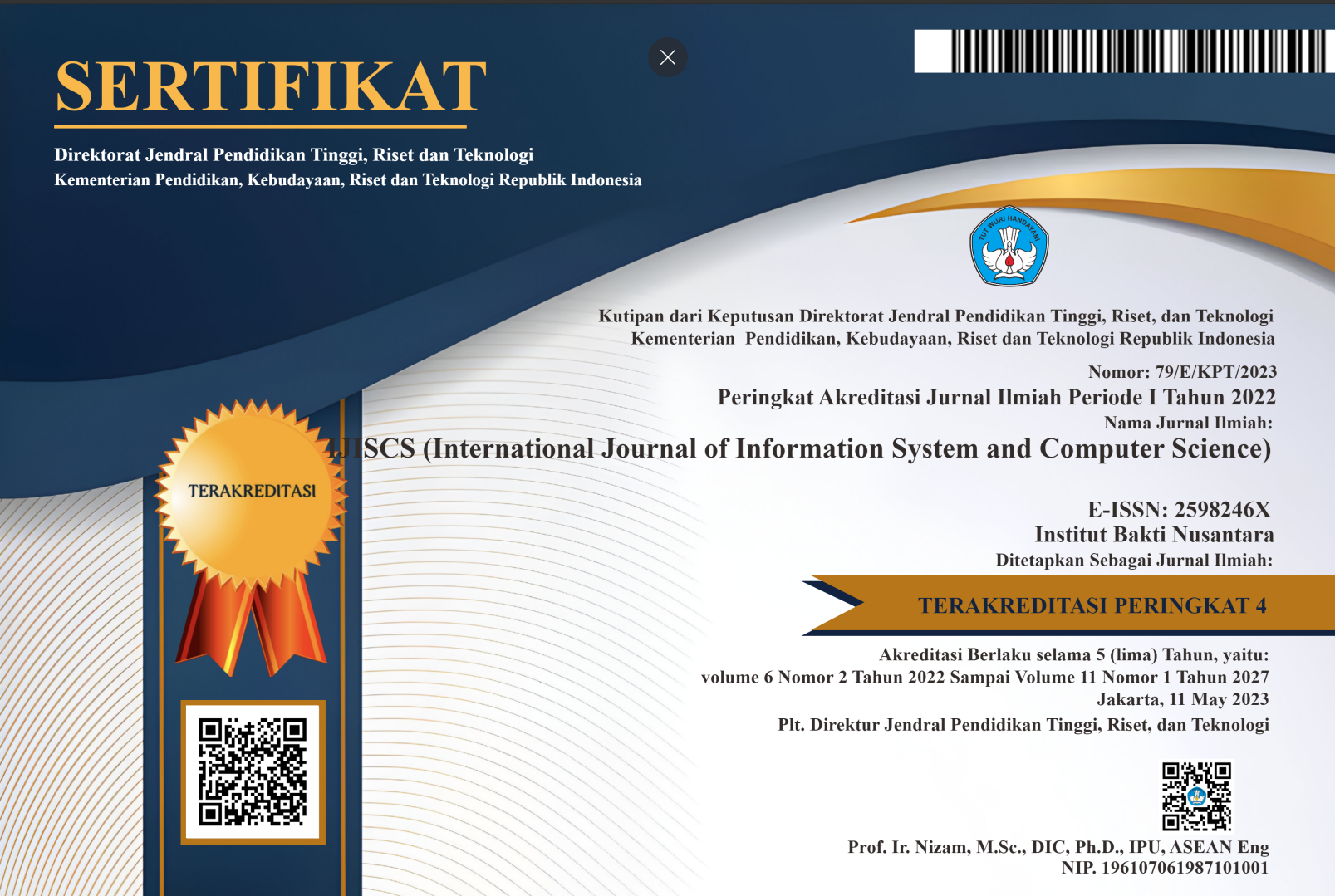DESIGN AND BUILD VR HORROR GAMES WITH PROCEDURAL CONTENT GENERATION USING CELLULAR AUTOMATA ALGORITHM
(1) Department of Informatic, University Multimedia Nusantara, Tangerang, Banten
(2) Department of Informatic, University Multimedia Nusantara, Tangerang, Banten
(3) Department of Informatic, University Multimedia Nusantara, Tangerang, Banten
 Corresponding Author
Corresponding Author
Abstract
The development of video games is very fast according to data obtained by ESA in 2021, about 226 million people on American played video games and in Indonesia 105 million people play video games and this will continue to increase, it is predicted that in 2025 video players gaming in Indonesia will reach 127 million people, this causes the need for game content continues to increase while for making game content it is not something that cheap, one way to reduce costs in making content in the game is to implement procedural content generation, procedural content generation is one way of creating content game automatically by using an algorithm. This research aims to design and build a virtual reality horror game using use cellular automata algorithm, cellular automata algorithm in research This research is used for map making, besides that this research also aims to measure the level of player satisfaction with the game that has been made. Game created using the Unity 3D game engine and the C# programming language. After game has been successfully built, will measure the level of satisfaction through cakes. questionnaire using GUESS-18, based on tests that have been carried out with GUESS-18, the results obtained are 77.1 percent, which can be concluded that the level of player satisfaction is categorized as good.
Keywords
References
Vuontisjärvi H, “Procedural Planet Generation in Game Development,” 2014.
M. Hendrikx, S. Meijer, J. Van Der Velden, and A. Iosup, “Procedural content generation for games: A survey,” ACM Trans. Multimed. Comput. Commun. Appl., vol. 9, no. 1, 2013, doi: 10.1145/2422956.2422957.
C. Fajri, “Tantangan Industri Kreatif-Game Online di Indonesia,” J. ASPIKOM, vol. 1, no. 5, p. 443, 2012, doi: 10.24329/aspikom.v1i5.47.
J. Sampurna, W. Istiono, and A. Suryadibrata, “Virtual Reality Game for Introducing Pencak Silat,” Int. J. Interact. Mob. Technol., vol. 15, no. 1, pp. 199–207, 2021, doi: 10.3991/IJIM.V15I01.17679.
N. A. Barriga, “A Short Introduction to Procedural Content Generation Algorithms for Videogames,” Int. J. Artif. Intell. Tools, vol. 28, no. 2, 2019, doi: 10.1142/S0218213019300011.
I. Parberry, “Designer Worlds: Procedural Generation of Infinite Terrain from Real-World Elevation Data,” J. Comput. Graph. Tech., vol. 3, no. 1, pp. 74–85, 2014, [Online]. Available: http://jcgt.org/published/0003/01/04/
A. A. Permana, A. T. Perdana, and Y. E. Ramadhan, “Mobile Educational Game of Animal Guess in Android Platform,” JIKA (Jurnal Inform., vol. 6, no. 3, p. 317, 2022, doi: 10.31000/jika.v6i3.6811.
M. Andersson and S. Kvarnström, “Procedural Generation of a 3D Terrain Model Based on a Predefined Road Mesh,” 2017, [Online]. Available: https://gupea.ub.gu.se/handle/2077/53338
G. Smith, “The future of procedural content generation in games,” AAAI Work. - Tech. Rep., vol. WS-14-16, no. Persson, pp. 53–57, 2014, doi: 10.1609/aiide.v10i3.12748.
S. Risi, J. Lehman, D. B. D. Ambrosio, and K. O. Stanley, “Automatically Categorizing Procedurally Generated Content for Collecting Games,” Proc. Work. Proced. Content Gener. Games 9th Int. Conf. Found. Digit. Games (FDG-2014)., 2014, [Online]. Available: http://eplex.cs.ucf.edu/papers/risi_pcg14.pdf
G. N. Yannakakis and J. Togelius, “Experience-driven procedural content generation (Extended abstract),” 2015 Int. Conf. Affect. Comput. Intell. Interact. ACII 2015, pp. 519–525, 2015, doi: 10.1109/ACII.2015.7344619.
S. Putra and W. Istiono, “Implementation Simple Additive Weighting in Procedural Content Generation Strategy Game,” vol. 4, no. 12, pp. 9–18, 2022.
R. Lara-Cabrera, C. Cotta, and A. J. Fernandez-Leiva, “Procedural map generation for a RTS game,” 13th Int. Conf. Intell. Games Simulation, GAME-ON 2012, pp. 53–58, 2012.
“Game Programming Gems 3.pdf.”
R. Andrian, A. A. Permana, and A. Kusnadi, “Design Adventure Role Playing Game With Procedural Content Generation Using Perlin Noise Algorithm,” J. Theor. Appl. Inf. Technol., vol. 101, no. 9, pp. 3653–3665, 2023.
E. R. T. Harsaya, A. A. Permana, and Y. Khaeruzaman, “Design Application Simple Learn Based on Mobile With Implementation Gamification for Learning Online,” J. Theor. Appl. Inf. Technol., vol. 101, no. 6, pp. 2255–2262, 2023.
M. B. Temuçin, İ. Kocabaş, and K. Oğuz, “Using Cellular Automata as a Basis for Procedural Generation of Organic Cities,” Eur. J. Eng. Res. Sci., vol. 5, no. 12, pp. 116–120, 2020, doi: 10.24018/ejers.2020.5.12.2293.
C. Anagha Zachariah, G. Pankaj Kumar, D. R. Umesh, and M. N. Arun Kumar, “Terrain generation from user text using cellular automata,” Int. J. Recent Technol. Eng., vol. 8, no. 3, pp. 8041–8045, 2019, doi: 10.35940/ijrte.C6425.098319.
C. Adams, H. Parekh, and S. J. Louis, “Procedural level design using an interactive cellular automata genetic algorithm,” pp. 85–86, 2017, doi: 10.1145/3067695.3075614.
M. Cook, J. Gow, and S. Colton, “Danesh: Helping bridge the gap between procedural generators and their output,” Proc. 7th Work. Proced. Content Gener., pp. 1–16, 2016.
L. Johnson, G. N. Yannakakis, and J. Togelius, “Cellular automata for real-time generation of infinite cave levels,” Work. Proced. Content Gener. Games, PC Games 2010, Co-located with 5th Int. Conf. Found. Digit. Games, no. May, 2010, doi: 10.1145/1814256.1814266.
T. H. Apperley, “Genre and game studies: Toward a critical approach to video game genres,” Simul. Gaming, vol. 37, no. 1, pp. 6–23, 2006, doi: 10.1177/1046878105282278.
Article Metrics
Abstract View : 417 times
: 417 times Download : 215 times
Download : 215 times
DOI: 10.56327/ijiscs.v7i2.1568
Refbacks
- There are currently no refbacks.






